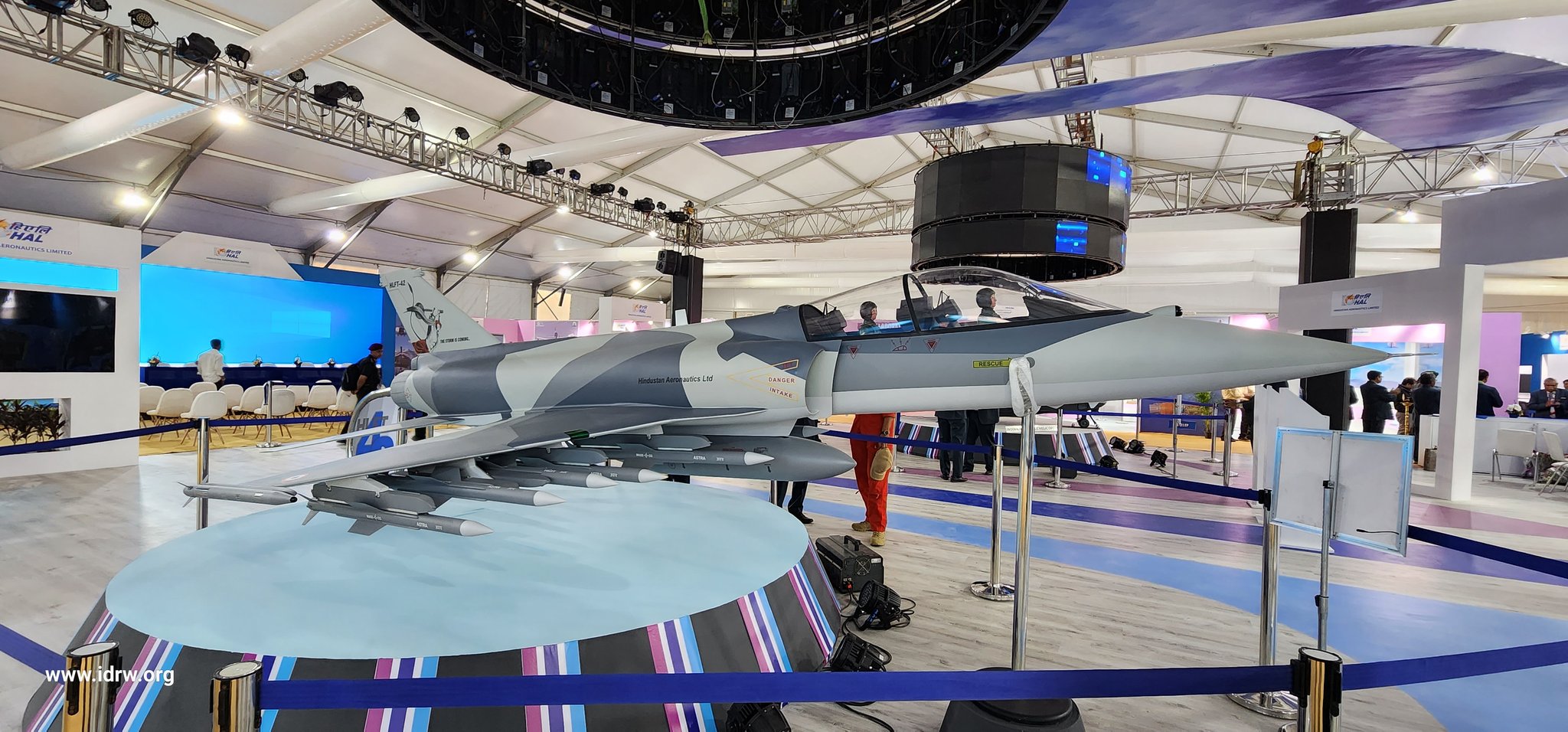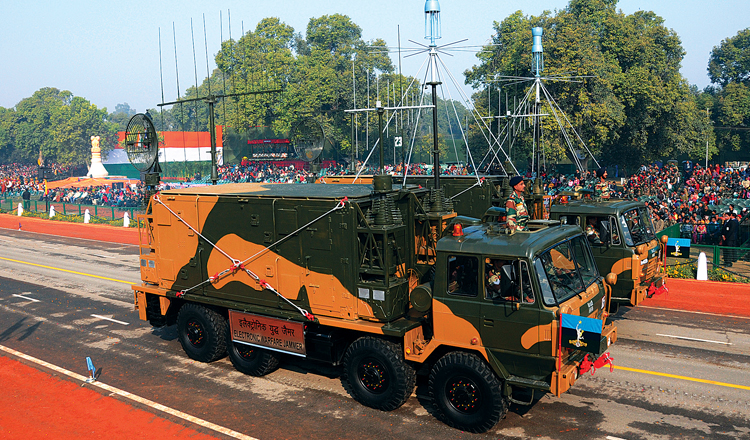SOURCE: PTI


A suspected spy was arrested in Panipat district on Tuesday for allegedly supplying sensitive information to some individuals in Pakistan, Haryana Police said. The suspect, Nauman Ilahi (24), is from Kairana in Uttar Pradesh, who had been working as a private security guard in the district, the police said on Wednesday.
“…(Ilahi) was in contact with some people in Pakistan and was supplying sensitive information to them,” Karnal SP Ganga Ram Punia, who is also holding an additional charge as Panipat SP, said.
Continue readingSOURCE: RAUNAK KUNDE / NEWS BEAT / IDRW.ORG


Hindustan Aeronautics Limited (HAL) has officially kicked off the search for a suitable engine to power its ambitious Hindustan Lead-in Fighter Trainer (HLFT-42), a next-generation supersonic trainer designed to prepare pilots for India’s advanced combat aircraft. On March 17, 2025, HAL issued a Request for Information (RFI) to global engine vendors, specifying a thrust requirement of 95-100 kilonewtons (kN) and a total technical life of 6,000 hours.
As the hunt intensifies, the General Electric F414 emerges as the frontrunner, but whispers of HAL’s under-development 110kN engine for the Advanced Medium Combat Aircraft (AMCA) suggest a potential shift toward engine commonality—a move that could redefine the HLFT-42’s role in training future AMCA pilots.
Continue readingSOURCE: RAUNAK KUNDE / NEWS BEAT / IDRW.ORG


In a recent escalation of tensions in the Arabian Sea, the Indian Navy’s deployment of MiG-29K fighter jets armed with two Rampage Air-Launched Ballistic Missiles (ALBMs) has reportedly unnerved the Pakistani military, prompting the Pakistan Air Force (PAF) to deploy F-16 fighter jets to safeguard its strategic Karachi Naval Base and other key assets in the region, according to an official familiar with the development. The Indian Navy’s move, supported by its aircraft carriers INS Vikrant and INS Vikramaditya, underscores its growing maritime dominance and has heightened alertness along Pakistan’s coastline.
The Indian Navy’s MiG-29K, a carrier-based multirole fighter, has recently been integrated with the Rampage air-to-ground missile, a high-speed, long-range weapon developed by Israel. With a strike range of approximately 250 kilometers, the Rampage missile significantly enhances the MiG-29K’s ability to target strategic installations, including naval bases, radar stations, and coastal infrastructure, from a safe distance. The missile’s precision and high-speed low-drag design make it a potent tool for striking high-value targets, as demonstrated by its use by Israel against Iranian military installations.
Continue readingSOURCE: RAUNAK KUNDE / NEWS BEAT / IDRW.ORG


In a significant endorsement of India’s growing defence manufacturing ecosystem, Lockheed Martin, the American aerospace and defence giant, has highlighted the country’s remarkable progress in producing critical components for its C-130J Super Hercules aircraft. According to a recent statement, 96% of the wings for the C-130J, a versatile tactical airlifter used by the Indian Air Force (IAF), are now manufactured in India. This milestone underscores India’s emergence as a key player in global defence supply chains and aligns with the government’s “Make in India” initiative.
The achievement is a result of Lockheed Martin’s collaboration with Tata Advanced Systems Limited (TASL), its Indian partner based in Hyderabad. The Tata-Lockheed Martin Aerostructures Limited (TLMAL) facility has been instrumental in producing complex aerospace components, including the C-130J wings. Since the partnership began, the facility has progressively localized production, reducing reliance on imported components and enhancing India’s self-reliance in defence manufacturing.
Continue readingSOURCE: AFI


In a significant development during the recent India-Pakistan clash, India has claimed a decisive victory in countering Pakistan’s use of the Chinese-supplied PL-15E beyond-visual-range air-to-air missiles (BVRAAMs). The Indian Air Force (IAF) successfully neutralized the missiles, fired by Pakistan Air Force (PAF) jets such as the JF-17 Block III and J-10CE, through advanced electronic warfare (EW) techniques. According to Indian defense officials, the IAF’s EW systems effectively jammed the datalink and seeker of the PL-15E missiles, rendering them ineffective during long-range engagements aimed at Indian fighter jets.
The clash, part of escalating tensions following the Pahalgam terror attack on April 22, 2025, saw Pakistan deploy its Chinese-supplied arsenal in an attempt to challenge India’s air superiority. The PL-15E, an export variant of China’s advanced PL-15 missile, boasts a range of 145 km, an active electronically scanned array (AESA) radar seeker, and a two-way datalink for mid-course updates. Despite these features, India’s robust EW capabilities disrupted the missile’s guidance systems, preventing it from locking onto IAF jets like the Rafale and Su-30 MKI. This success underscores India’s technological edge in modern aerial warfare, particularly in countering advanced missile systems.
Continue readingSOURCE: AFI


On May 10, 2025, the Indian Air Force (IAF) executed a precision missile strike on Pakistan’s Nur Khan Airbase in Rawalpindi as part of Operation Sindoor, a retaliatory operation targeting multiple Pakistani military installations. Satellite imagery from Maxar Technologies and Chinese firm MizarVision, released shortly after the strike, has provided compelling evidence of the damage inflicted, with a particular focus on a large Transporter Erector Launcher (TEL) truck structure hit by a BrahMos supersonic cruise missile.
Speculation is rife that this TEL could be associated with Pakistan’s Shaheen-III ballistic missile, though it remains unclear whether the truck was carrying a missile or was empty at the time of the strike. This article examines the before and after imagery, the significance of the strike, and the unanswered questions surrounding the targeted TEL.
Continue readingSOURCE: AFI


In a stunning display of technological prowess, the Indian Air Force (IAF) successfully bypassed and jammed Pakistan’s Chinese-supplied air defence systems, completing a critical mission in just 23 minutes. The operation, confirmed by the Indian Ministry of Defence (MoD), underscores India’s growing technological edge in modern warfare and its ability to neutralize sophisticated enemy defenses with precision and speed.
According to the MoD, the IAF executed the mission with remarkable efficiency, penetrating Pakistan’s air defence network and achieving its objectives without detection or interception. The operation involved advanced electronic warfare (EW) techniques, enabling the IAF to jam and suppress Pakistan’s radar and missile systems, rendering them ineffective for the duration of the mission.
Continue readingSOURCE: AFI


On May 15, 2025, a significant incident unfolded in the skies above Kashmir, as Indian Defence Forces successfully shot down a Turkish-manufactured drone, drawing comparisons to the advanced YIHA-III drones of the Pakistani Air Force (PAF). The wreckage of the drone was discovered entangled in high-tension electricity wires, underscoring the intensity of the aerial engagement and the growing role of unmanned aerial vehicles (UAVs) in the region’s ongoing conflict.
The drone, believed to be a Turkish model, was reportedly conducting surveillance or a potential strike mission over Indian-controlled territory in Kashmir. Indian forces, maintaining heightened vigilance in the region, detected the UAV and swiftly neutralized it using anti-aircraft systems. The debris, which includes a charred and mangled frame, was found hanging precariously on electrical wires, as captured in a striking image shared by the handle @goreuni1. The photograph reveals a cylindrical body with remnants of advanced avionics, hinting at the sophisticated technology embedded in the drone.
Continue readingSOURCE: PTI


India appears to have had a “clear edge” in targeting Pakistan’s military facilities and airfields during the recent four-day confrontation, the New York Times reported, citing satellite images. High-resolution satellite imagery, from before and after the strikes, shows “clear damage” to Pakistan’s facilities by Indian attacks, according to the report.
“The four-day military clash between India and Pakistan was the most expansive fighting in half a century between the two nuclear-armed countries. As both sides used drones and missiles to test each other’s air defences and hit military facilities, they claimed to inflict severe damage,” the report said.
Continue readingSOURCE: IANS


India’s Operation Sindoor gave a deadly blow to Pakistan, demolished its terror infrastructure and also left its political leadership humiliated and exposed before the world. The Indian military decimated its safe havens for terrorists as well as Pakistani air bases in response to its escalation; however, the rogue nation stuck to its character and kept upping the ante against Indian action.
Defeated on the battlefield, it opened a new front against India and desperately attempted to sell false narratives about India’s ‘defeat’, the fall of its fighter jets, to project itself as a ‘winner’ in the digital space. A couple of its friendly nations, allegedly Turkiye and China, also helped it in peddling this fabricated narrative by tacit or direct means.
Continue readingSOURCE: REUTERS


India said on Wednesday that it rejects China’s move to rename places in the northeastern state of Arunachal Pradesh where the Asian neighbours share a border, adding that the Himalayan territory was an integral part of India.
Beijing has renamed places in Arunachal Pradesh in the past as well and the issue has been an irritant in ties between the two countries, especially as they deteriorated sharply after a deadly military clash elsewhere on their border in 2020.
Continue readingSOURCE: PTI
)

India’s trade relations with Turkey and Azerbaijan are expected to come under strain due to Ankara and Baku backing Islamabad and condemning India’s recent strikes on terror camps in Pakistan. Following their support to Pakistan, calls for Turkish goods and tourism have surfaced across the country, with online travel platforms such as EaseMyTrip and Ixigo issuing advisories against visiting these nations.
In fact, Indian traders too have started boycotting Turkish products such as apples and marble. India launched Operation Sindoor on May 7 to destroy nine terror infrastructures in Pakistan and Pakistan-occupied-Kashmir in retaliation for the Kashmir’s Pahalgam terror attack on April 22.
Continue readingSOURCE: ANI


In a historic success in the resolve of a ‘Naxal-free India,’ the security forces have killed 31 Naxalites in the biggest-ever 21-operation against Naxalism, on the Karreguttalu Hill (KGH) at the Chhattisgarh-Telangana border. A total of 214 Naxal hideouts and bunkers have been destroyed in the operation, and a total of 450 IEDs, 818 BGL shells, 899 bundles of Codex, detonators and a huge amount of explosive material have been recovered during the searches.
In addition, nearly 12,000 kilograms of food supplies have also been recovered. As part of the operation, the security forces also destroyed four Naxal technical units that were being used for the production of BGL shells, homemade weapons, IEDs, and other deadly weapons. During the operation, a large quantity of ration supplies, medicines, and daily-use items were also recovered from various Naxal hideouts and bunkers. In the significant operation, a total of 18 personnel from Commando Battalion for Resolute Action (CoBRA), Special Task Force (STF) and District Reserve Guards (DRG) were injured in various IED explosions.
Continue readingSOURCE: PTI
)

Prime Minister Narendra Modi on Wednesday said the killing of 31 Naxalites along the Chhattisgarh-Telangana border underscores that the government’s campaign to root out left-wing extremism is moving in the right direction.
In a post on X, Modi said his government is committed to establishing peace in the Naxal-affected region and connecting it to the mainstream of development.Home Minister Amit Shah had earlier said the security forces achieved a historic breakthrough in the resolve to make the country Naxal-free with the killing of 31 notorious Naxalites in the Karregutta hills along the Chhattisgarh-Telangana border.
Continue readingSOURCE: PTI
)

Saudi Arabia’s Crown Prince Mohammed bin Salman on Wednesday welcomed the “ceasefire” agreement between Pakistan and India, expressing hope that it will restore calm between the two neighbours.
Prince Mohammed made the remarks while delivering a speech during a meeting of leaders from the Gulf Cooperation Council (GCC) and US President Donald Trump in the Saudi capital Riyadh. “We welcome the ceasefire agreement between Pakistan and India,” he was quoted as saying by the state-owned Saudi Press Agency.
Continue reading